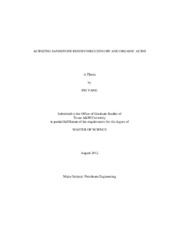| dc.description.abstract | Mud acid, which is composed of HCl and HF, is commonly used to remove the formation damage in sandstone reservoirs. However, many problems are associated with HCl, especially at high temperatures.
Formic-HF acids have served as an alternative of mud acid for a long period. Several factors may influence the outcome of an acidizing job in sandstone formations. In this research, effects of mineralogy, temperature, and HF concentration were studied. Various clay minerals (kaolinite, chlorite, and illite) were examined to react with formic-HF acid mixtures which contain different concentrations of HF. Coreflood experiments on sandstone cores featured by different mineralogy with dimensions of 1.5 in. x 6 in. were also conducted at a flow rate of 5 cm^3/min. Formic or acetic acids were used in preflush stage to remove the carbonates. A series of formic-HF acid mixtures with different ratios and concentrations were tested, and temperature varied from 77 to 350 degrees F. Inductively coupled plasma (ICP), scanning electron microscopy (SEM) and 19F nuclear magnetic resonance (19F NMR) were employed to follow the reaction kinetics and products. Besides, acetic-HF acid system, which is another important alternative of mud acid, was also investigated to compare with formic-HF acids.
The species and amounts of reaction products of different clay minerals in organic-HF acids depend on mineral type, acid composition and ratio, and this is further confirmed by coreflood experiments, in which sandstone cores with different mineral compositions give quite different responses to the same acid mixture. As preflush, formic acid becomes more effective in removing carbonate minerals in sandstone cores at higher temperatures. In main flush stage, more concentrated HF can react with more clay minerals, but can also cause higher risk of CaF2 precipitate. Both formic-HF and acetic-HF acids are much milder than mud acid. When reacting with clay minerals, there is no big difference in the behaviors of 13 wt% acetic-HF acids and 9 wt% formic-HF acids, as long as the HF concentrations are the same. | en |


